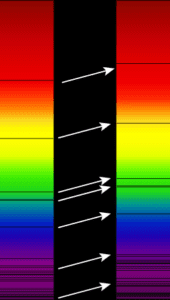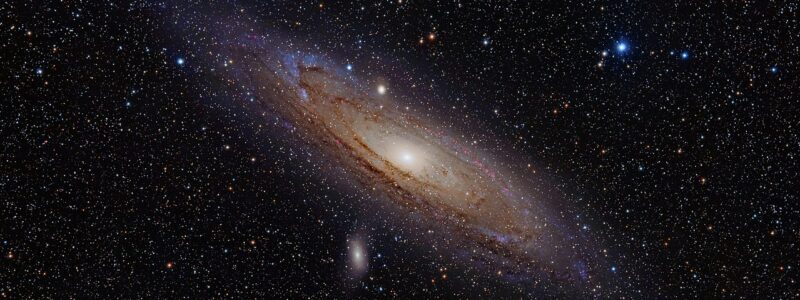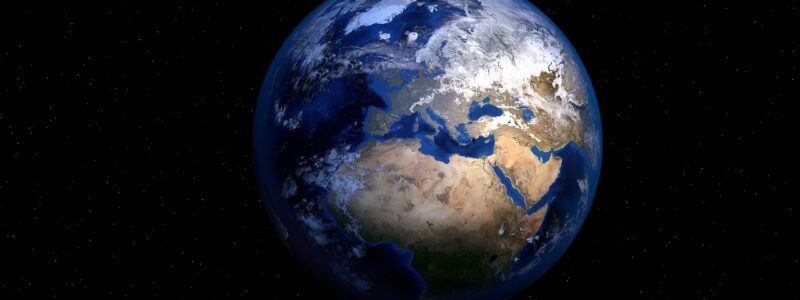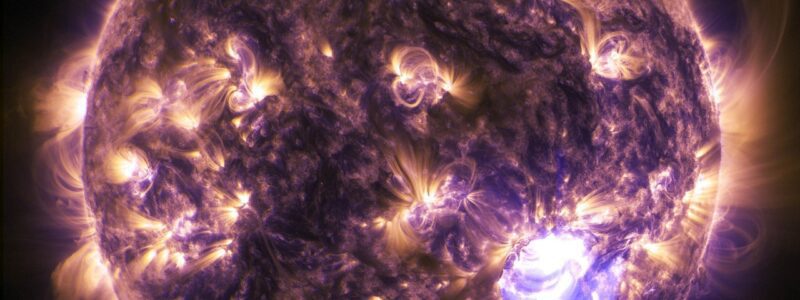The Expanding Universe
The twentieth century was changed by the discovery of the expanding universe. This discovery changed our view of the Universe and out place within it.
Before the telescope was invented by Galileo in 1610, astronomers believed the universe consisted of only a few thousand stars and a few dozen nebulae.
Telescopes and optics improved substantially over the nineteenth century allowing better and deeper visualization of the cosmos. By the end of the century, the universe seemed endless with billions of stars and millions of nebulae.
There seemed to be no end in sight – there seemed to be no boundary to the universe. Better telescopes with greater light gathering ability captured endless numbers of stars in all directions.
Kant’s endless universe hypothesis seemed confirmed by observation and Newtonian physics. Everything from the motion of plants to the motion of comets, asteroids, binary stars, stars in star clusters – everything matched the predictions of the known physics.
Kant’s claim that everything about the universe could be accounted for by the laws of motion, and that the universe was infinite in size and time became more accepted. His cosmological model went from a hypothesis to a theory, and then to an accepted fact.
Kant’s cosmology became the consensus opinion of modern science and was largely unchallenged. This is because it bit the biases of scientists that the Universe and time were infinite. This “fact” meant there was no need for a Creator.
And then, scientists saw the light.
Einstein’s Discovers Relativity
A German-born Swiss patent officer who studied physics in his spare time published several papers of tremendous significance in 1905. He was able to show how there is no absolute reference system in space, and that the velocity of light was constant with respect to all observers and never varies.
He then went on to publish several more papers in 1915 and 1916 which provided the equations of general relativity; these equations carry profound implications as to the origin and ultimate destiny of the universe and have tremendous theological implications as we will see.
Many scientists then used Einsteins theories to establish a consistent view of the expanding universe. In 1912, Vesto Slipher found that light from a nebula (now known to be a galaxy) had a significant redshift and correctly interpreted this finding as meaning the object was moving away from us at great velocity.
We are all familiar with a change in sound frequency when the sound moves past us (as with an ambulance or a train). When the train is coming toward us, the sound waves are compressed and the sound has a higher pitch; when the train goes away from us, the pitch then falls as the sound waves are decompressed.

Red Shift – left side is the Sun, the right side is a celestial object moving away.
Similarly, when a celestial object moves away from us, the light frequency is stretch and the spectrum is changed such that the absorption lines move toward the red end of the spectrum. The greater the shift, the greater the velocity.
The Expanding Universe
Alexander Friedmann derived the Friedmann equations from Einstein’s field equations showing the universe might expand at a rate that could be calculable. George Lemaitre independently found a similar solution several years later in 1927. The first hint of the expanding universe was derived from math – not observation.
Edwin Hubble then evaluated this proposed expansion of the universe by measuring the relative velocities of forty different galaxies in 1929. He was able to show that the galaxies are moving away from us in a manner predicted by Einstein’s formulation of general relativity.
Hubble showed the more distant a galaxy is from us the observer, the greater its velocity is away from us. Winding time backward, the implication was that in the distant past the entire universe was much small, and at some time in the remote past, the universe had a beginning.
The implication of a cosmic beginning was just too much for many non-religious cosmologists to tolerate; there must be some other solution to the problem of a possible Universe origin.
For example, Sir Arthur Eddington fought against the entire concept of the universe having a beginning. He was an astrophysicist and mathematician who popularized science and who correctly surmised the possibility that stars used the fusion of hydrogen into helium for their energy production in 1920. He wrote,
Philosophically, the notion of a beginning of the present order of Nature is repugnant … I should like to find a genuine loophole.
The reason why he found this “notion” so “repugnant” was due to his ultimate respect for evolution, stating,
We [must] allow evolution an infinite time to get started.
Universe Has a Beginning
Probably the most controversial aspect of the expanding universe was that it implied a beginning of the Universe. This was particularly troublesome for atheist scientists as a beginning would imply a Beginner.
Many of these early scientists let their atheism interfere with their science. Skeptics believed there could be no God, and any consideration of a Creator could not be a part of science.
Einstein’s Beliefs about God
Einstein was a personal witness to some of the worst tragedies to befall mankind living through the early days of Nazi Germany. He became convinced there could not be a God who was personally interested in mankind and yet would allow such a disaster to occur. Concerning this paradox between an omnipotent God and man’s free will with responsibility for his actions, Einstein wrote,
If this Being is omnipotent, then every occurrence, including every human action, every human thought, and every human feeling and aspiration is also His work; how is it possible to think of holding men responsible for their deeds and thoughts before such an almighty Being? In giving out punishment and rewards He would to a certain extent be passing judgment on Himself. How can this be combined with the goodness and righteousness ascribed to him?
Einstein was never given a satisfactory explanation to this problem of theodicy by the religious professionals of his day. Einstein certainly lived through a time of tremendous evil in the world, and barely escape Nazi Germany. He would eventually come to a belief there was no answer to the problem of evil. Lacking a solution to this paradox, Einstein ruled out the existence of a personal God. However, and this is important, Einstein never lost his belief in a Creator.
Hubble Time and The Expanding Universe
Hubble’s research not only confirmed the universe was expanding calculated a rate for this expansion. It then became relatively easy to determine when the universe began – the “Hubble Time.” The initial values were from a few to several billion years.
This proved to be a problem, for paleontologists and origin-of-life biologists agree this time is too short for life to arise through natural evolution. Many of these scientists invested considerable time and energy into trying to derive a “loophole” around Hubble Time and its obvious theological implications.
Probably the most popular idea was something called the Steady State Universe.
Steady State Universe. The steady state universe attempts to circumvent the implications of an expanding universe. It does this by proposing that voids made by expansion were continuously being filled with new matter. This would be new matter popping into existence from nothing.
This hypothesis suggested the creation of all matter was not a singular event in the past, but rather a continuous, spontaneous self-creation through some unknown process. The theory was proposed in 1948 by British astronomers Herman Bondi, Thomas Gold, and Fred Hoyle.
Hoyle especially was very clear about their opposition to any divine cause for the Universe. He stated “the Universe is everything” and to suggest otherwise was “crackpot.” There was no explanation at the time as to how everything could be made out of nothing. However the point was the theory obviated the need for a Creator.
Anything becomes possible with an infinite amount of time; even a planet teeming with life such as the earth.
The Steady State Universe seemed like an ideal “solution” to the expanding universe problem – but only for a short time.
Testing the Steady State Universe
A theory is only as good as its testability and observational confirmation The theory suggests that the universe is infinite in size and volume and that it should also be isotropic. The isotropic universe should appear the same in every direction, and at every distance. Therefore, the number of stars and galaxies should appear the same everywhere. There should be similar contributions from young, middle-aged, and elderly stars and galaxies at every distance.
The main advantage of the steady state universe was it allowed the expanding universe but not an absolute beginning. The universe was constantly expanding but was infinite in size. This means no beginning was needed.
Larger and more sophisticated telescopes show the steady state universe model is wrong.
Proving the Steady State Universe Wrong
The further back in time the closer galaxies are to each other. The steady state theory would suggest all galaxies should be at about the same average distance.
Stars throughout the galaxy are relatively “youthful” ranging in age for a few years to about 13.5 billion years in age. Since most stars in the universe can burn for more than 80 billion years, finding none older than 13.5 billion years poses a significant challenge to the concept of an eternal universe. White dwarf stars, the remnants of burned out stars, none of them have transitioned to black dwarfs; this transition would take about 100 billion years.
There are virtually no newly formed galaxies older than about a half billion years; all the galaxies appear to be about the same age, but there are none which are older than 14 billion years, and that all galaxies are about the same age.
But the steady state hypothesis really met its end with the discovery that the cosmic microwave background radiation spectrum perfectly fits that of a black body radiator. This means the universe was much hotter in the past than it is now and was certainly not in a “steady state.” The cooling curve of the cosmic background radiation indicates it was extremely hot about 13.8 billion years ago. The universe can not cool through radiation to an outside source (since there is none); it can only cool through cosmic expansion.
The steady-state hypothesis now has been discarded as a viable theory because it cannot explain observational data.
Summary
Einstein’s theories concerning relativity and especially his equations of general relativity established the universe for a beginning. This beginning was supported by mathematical extensions by Friedmann and Lemaitre
Relativity has been shown to be exceedingly reliable in describing all natural phenomenon as will be described in subsequent posts; in fact, it is the most precisely defined theory in science. The physical origin of the universe at a point in time is one of the best-described facts of science but also one of the most controversial.
Stephen Hawking was immensely disturbed by the obvious theological implications. He struggled to develop alternative explanations for the beginning of the universe including imaginary time.
Other scientists struggled to develop alternative explanations. This is done to avoid the need for an absolute beginning in time and space.




